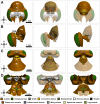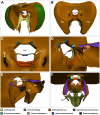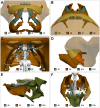A three-dimensional atlas of the honeybee neck
- PMID: 20520729
- PMCID: PMC2875396
- DOI: 10.1371/journal.pone.0010771
A three-dimensional atlas of the honeybee neck
Abstract
Three-dimensional digital atlases are rapidly becoming indispensible in modern biology. We used serial sectioning combined with manual registration and segmentation of images to develop a comprehensive and detailed three-dimensional atlas of the honeybee head-neck system. This interactive atlas includes skeletal structures of the head and prothorax, the neck musculature, and the nervous system. The scope and resolution of the model exceeds atlases previously developed on similar sized animals, and the interactive nature of the model provides a far more accessible means of interpreting and comprehending insect anatomy and neuroanatomy.
Conflict of interest statement
Figures











Similar articles
-
Three-dimensional average-shape atlas of the honeybee brain and its applications.J Comp Neurol. 2005 Nov 7;492(1):1-19. doi: 10.1002/cne.20644. J Comp Neurol. 2005. PMID: 16175557
-
Three-dimensional interactive and stereotactic atlas of head muscles and glands correlated with cranial nerves and surface and sectional neuroanatomy.J Neurosci Methods. 2013 Apr 30;215(1):12-8. doi: 10.1016/j.jneumeth.2013.02.005. Epub 2013 Feb 14. J Neurosci Methods. 2013. PMID: 23416136
-
A digital three-dimensional atlas of the honeybee antennal lobe based on optical sections acquired by confocal microscopy.Cell Tissue Res. 1999 Mar;295(3):383-94. doi: 10.1007/s004410051245. Cell Tissue Res. 1999. PMID: 10022959
-
[Surgical planes of the head and neck].Actas Dermosifiliogr. 2011 Apr;102(3):167-74. doi: 10.1016/j.ad.2010.07.005. Epub 2011 Feb 24. Actas Dermosifiliogr. 2011. PMID: 21353190 Review. Spanish.
-
Anatomy of Neck Muscles, Spaces, and Lymph Nodes.Neuroimaging Clin N Am. 2022 Nov;32(4):831-849. doi: 10.1016/j.nic.2022.07.027. Epub 2022 Sep 21. Neuroimaging Clin N Am. 2022. PMID: 36244726 Review.
Cited by
-
Visual response properties of neck motor neurons in the honeybee.J Comp Physiol A Neuroethol Sens Neural Behav Physiol. 2011 Dec;197(12):1173-87. doi: 10.1007/s00359-011-0679-9. Epub 2011 Sep 11. J Comp Physiol A Neuroethol Sens Neural Behav Physiol. 2011. PMID: 21909972
-
The loss of flight in ant workers enabled an evolutionary redesign of the thorax for ground labour.Front Zool. 2020 Oct 19;17:33. doi: 10.1186/s12983-020-00375-9. eCollection 2020. Front Zool. 2020. PMID: 33088333 Free PMC article.
-
Visualising mouse neuroanatomy and function by metal distribution using laser ablation-inductively coupled plasma-mass spectrometry imaging.Chem Sci. 2015 Oct 1;6(10):5383-5393. doi: 10.1039/c5sc02231b. Epub 2015 Jul 27. Chem Sci. 2015. PMID: 29449912 Free PMC article.
-
Systematics of the ant genus Proceratium Roger (Hymenoptera, Formicidae, Proceratiinae) in China - with descriptions of three new species based on micro-CT enhanced next-generation-morphology.Zookeys. 2018 Jun 4;(770):137-192. doi: 10.3897/zookeys.770.24908. eCollection 2018. Zookeys. 2018. PMID: 30002593 Free PMC article.
-
Neural basis of forward flight control and landing in honeybees.Sci Rep. 2017 Nov 6;7(1):14591. doi: 10.1038/s41598-017-14954-0. Sci Rep. 2017. PMID: 29109404 Free PMC article.
References
-
- Odgaard A, Andersen K, Melsen F, Gundersen HJ. A direct method for fast three-dimensional serial reconstruction. J Microsc. 1990;159:335–342. - PubMed
-
- Weninger WJ, Meng S, Streicher J, Müller GB. A new episcopic method for rapid 3-D reconstruction: applications in anatomy and embryology. Anat Embryol. 1998;197:341–348. - PubMed
-
- Brandt R, Rohlfing T, Rybak J, Krofczik S, Maye A, et al. Three-dimensional average-shape atlas of the honeybee brain and its applications. J Comp Neurol. 2005;492:1–19. - PubMed
-
- Kelber C, Rossler W, Kleineidam CJ. Multiple olfactory receptor neurons and their axonal projections in the antennal lobe of the honeybee Apis mellifera. J Comp Neurol. 2006;496:395–405. - PubMed
Publication types
MeSH terms
LinkOut - more resources
Full Text Sources

